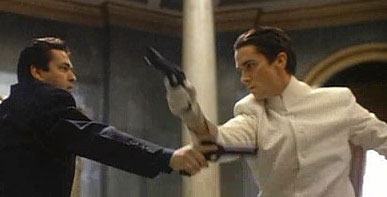
 |
EquilibriumDystopian Repression and “Gun-Kata” |
Title: Equilibrium
Director: Kurt Wimmer
Starring: Christian Bale, Emily Watson, Taye Diggs
Released: 2002
Running Time: 1 hour, 47 minutes
MPAA Rating: R for violence
Freak Nation Rating: ![]()
![]()
![]()
![]()
Buy It From: Amazon.com
Kurt Wimmer’s Equilibrium somehow invites (and receives) unending comparison with the Wachowsky Brothers’ The Matrix — which is odd, because it’s a completely different movie. Sure, there are certain elements of commonality — a stoic hero trying to redeem a bleak and desolate future through superhuman feats of action and marksmanship — but beyond those bits (common to practically any near-future or cyberpunk action thriller these days), the two movies have little in common.
After some hotheaded and unwise individuals trigger a nuclear war, the surviving humans forsake emotion — forever and completely. All citizens of the new state of Libria must take their “daily dose” of Prozium, a drug that deadens all sentiment of any kind. John Preston (Christian Bale) is one of the Grammaton Clerics, the quasi-monastic order of über-warriors who enforce compliance with the dosage regime and hunt down “sense offenders” — anyone who attempts to have feelings, or to create or preserve artwork of any kind.
Like any good Grammaton Cleric, Preston remained completely uncaring even when his wife was taken away for sense offense, two years before the start of the movie. But when he accidentally misses his daily dose, emotions start welling up inside him, and he quickly becomes a very secret sense offender himself. From there, it’s clear where the plot will end, but the twists and turns it takes before getting there include at least a few original and unexpected ones.
Of course, the “totalitarian dystopia” is a classic sci-fi trope, and it’s impossible to do another one without tacitly referencing the classics that have gone before. Equilibrium doesn’t try to avoid such references; instead, it pointedly tips its hat to Bradbury’s Fahrenheit 451 (the Clerics consign artistic works — and sense offenders — to flame for destruction, and the hero is a member of the enforcement organization, as was Guy Montag) as well as Orwell’s 1984 (a forbidden romance is part of the hero’s fall from grace, as is an attempt to contact the underground resistance) and, inevitably, Huxley’s Brave New World (narcotized populace, blah blah, all citizens on drugs, yadda yadda — that one’s pretty obvious).
But Equilibrium manages — just barely — to play these off as homages and as knowledge of its source material rather than as slavish copying. Instead, its use of well-known thematic elements provides a familiar background onto which it can project the real touches of freshness and originality that bring it to life.
 John Preston (Christian Bale, wearing white) uses gun kata on an opponent. |
One of these, and the one that’s gotten the most attention, is the idea of Gun Kata. This synthetic martial-arts form, invented specifically for the Clerics (and for the movie), is based around “analysis of thousands of recorded gunfights,” theoretically showing that “the geometric distribution of antagonists in any gun battle is a statistically predictable phenomenon”. In other words, the Clerics have min-maxed the positioning of gunfights, allowing them maximum slaughter options while keeping themselves out of the way of return fire.
In actual practice, it looks completely unlike the wire-work action in The Matrix. The Cleric often stands in the midst of a throng of foes, his gun-laden hands moving fluidly through patterns that show some ancestry in Southern Style kung fu... and bullets fly in every direction, punctuated by muzzle flashes. While it would probably be a great way to get killed in real life, it does look cool — and completely unlike anything else we’ve seen before. The concept has generated enough excitement to get people to develop GURPS gun kata rules, and even an entire gun kata web site (though the domain name is misspelled, the text on the site isn’t).
 Taye Diggs plays up-and-coming Cleric Brandt with relish and style. |
The plotline and characterization also include some new elements. When Preston’s partner, played by Sean Bean, is discovered to be a sense offender (in a moving scene in which he quotes Yeats), Preston needs a replacement partner. Taye Diggs fills the role as Brandt, an ambitious young Cleric who starts off trumpeting his admiration for Preston and his career. But as the story progresses, his motives become more and more suspect. Diggs is obviously enjoying himself with the part, switching from sincerity to menace to innocence with smooth precision — and underlying gusto. He’s not quite like anything we’ve seen in previous dystopias; despite his professed desire to rid the world of all emotion, he seems to have a sense of humor. Set against the stoic Preston, he’s practically the life of the party. Even when you think he’s a slime who’s about to stab Preston in the back, you can’t help but enjoy his performance.
Of course, there are flaws to this movie. Though writer-director Kurt Wimmer has added various spiffy new ideas to his plot and his world, the basic outline is still the totalitarian dystopia that’s been a staple of specualtive fiction for over half a century. Grafting a few new ideas onto that concept, no matter how well done, can’t quite make up for the fact that we’ve seen the underlying plot a few dozen times before. And Wimmer’s basic theme, that emotion is good, isn’t exactly novel or controversial. But these unavoidable problems aren’t particularly major.
A special word must be said about the overall look and design of this movie. The architecture has a very Futurist look to it (in the sense of the early 20th Century artistic movement, not just “futuristic” — think VNV Nation album cover art, or Fritz Lang’s Metropolis). Along with minimalist furniture and other set dressings, this design aesthetic has a very spare, almost utilitarian feel, which is deftly highlighted by the cinematography. Instead of the darting, swooping, and circular camera motions we’ve come to expect from movies like The Matrix and Lord of the Rings, Equilibrium opts for static and straight-on camera views, framing rectilinear vistas. In any other movie, it would feel disastrously low-rent; here, it instead blends seamlessly with the feel of an artistically barren culture where all emotion is suppressed.
Kai MacTane is the Freak Nation’s webmaster. He’s quite happy with having emotions, so don’t send him any spam offering to sell him cheap Prozium from online pharmacies. It will just get eaten by his spam filters, anyway. He has actually read 1984, Brave New World and Fahrenheit 451, so he’s no slouch in the “futuristic dystopia” department.